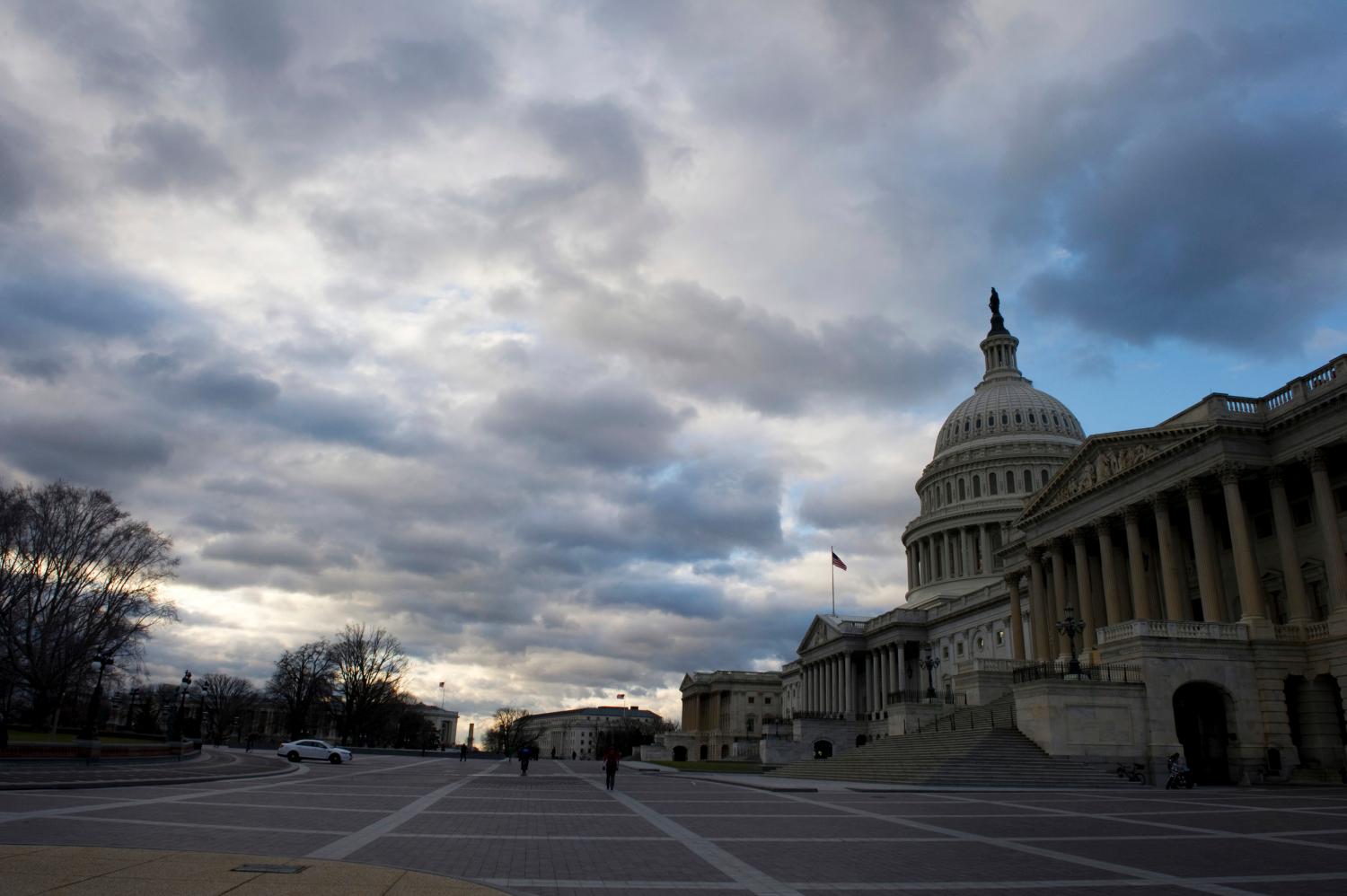The Air Force is mounting an all-out lobbying campaign to rescue the F-22 Raptor from attacks by Representative Jerry Lewis (R-CA) and other critics in Congress. In the Air Force’s view, many of these individuals simply need a “better education” about the F-22’s capabilities. Air Force Secretary F. Whitten Peters, for example, said that killing the program would “be wrong for national security” and “put American service members at unnecessary and unacceptable risk.” Defense Secretary William Cohen wrote Congress that he was so “dismayed” by the House’s recent decision not to provide production funding for the aircraft in the year 2000 budget that he “could not accept” it. Veto threats are already in the air, should a September House-Senate defense appropriations conference uphold the House vote.
However, the Pentagon’s support for the Raptor ignores a basic budgetary fact: that despite a good deal of recent pro-defense rhetoric from the White House and Congress, military spending is unlikely to increase substantially in the years ahead; consequently, the Pentagon will not be able to afford everything it wants. Given these resource constraints, the F-22 is not needed badly enough to justify the scarce dollars the Department of Defense intends to spend on it. Funding priorities such as troop readiness and advanced all-weather munitions are considerably more important.
The Case for the F-22
The Air Force and Secretary Cohen do have some arguments on their side. Control of the air has been a prerequisite to military victory in most wars of the last sixty years, and the F-22 boasts speed, stealth, computer capabilities, and avionics more advanced than anything we have today—and anything the rest of the world will be able to build in the next couple of decades. Notably, enemy radars would have much more trouble picking up the F-22 than detecting current fighters (see Figure 1). Given these attributes, the Raptor’s high production price tag—$125 million per aircraft, according to the latest Congressional Budget Office (CBO) estimate—is not unreasonable.
Figure 1:
The Benefits of Stealth
Note: Roughly speaking, the scale for radar cross sections corresponds to square meters for fighter aircraft. From certain angles, however, non-stealthy aircraft such as the F-15 can have radar cross sections of between 5 and 10 square meters.
Pentagon officials also are correct in saying that most of the money needed for F-22 research and development has already been spent. To cancel the program now would essentially throw away a $21 billion investment. The Air Force, moreover, has scaled back its intended number of F-22 purchases by more than half since the program was inaugurated in the 1980s, from 750 aircraft to 339.
The Budgetary Conundrum
Because it features a number of expensive weapons systems like the F-22—not to mention Joint Strike Fighters, F/A-18 E/F fighters, improved Army attack helicopters, and new Navy submarines—the Pentagon’s budget plan requires annual defense spending to increase by at least $20 billion in real terms in the future. But such a large boost in U.S. military spending does not appear likely during a period of relative peace. That means something has to give. If defense systems such as the F-22 are bought in large numbers, necessities such as military readiness will almost certainly suffer. The Pentagon would have to make some or all of the following tough choices: reduce military pay or benefits, scale back training, allow more equipment to sit idle awaiting repair, or skimp on research and development. New defense needs, such as anti-missile systems, other types of homeland defenses, and chemical and biological weapons gear, would also be shortchanged.
After a decade on “procurement holiday,” the Pentagon does need to buy new equipment to replace aging systems. That much is undeniable. The Pentagon, however, plans to replace its current weapons with far more expensive ones. As a result, to meet the Pentagon’s wish list, annual procurement spending would need to increase by a whopping $30 billion in the years ahead, roughly from $50 billion to $80 billion, and then remain at the higher real level indefinitely. (Indeed, Lane Pierrot of the CBO recently estimated that the Pentagon may need to spend as much as $90 billion a year on procurement to meet current plans.) Meanwhile, further savings from base closures, reductions in the Pentagon’s civilian workforce, and other economies would free up a maximum of $10 billion a year—meaning that most of the desired boost in procurement would have to come from higher defense spending.
So why can’t defense spending increase? After all, the nation is enjoying budget surpluses for the first time in three decades, and both political parties are pledging to put some of that surplus toward defense needs. In fact, President Clinton’s latest budget plan would provide adequate funding by the middle of the next decade (see Figure 2).
Figure 2:
U.S. Spending on National Defense
Note: QDR Requirement is the author’s estimate of what is needed to sustain the QDR force and the weapons modernization agenda of the Pentagon’s 1997 Quadrennial Defense Review. Figures include the U.S. Department of Energy’s spending on nuclear weapons.
Note: QDR Requirement is the author’s estimate of what is needed to sustain the QDR force and the weapons modernization agenda of the Pentagon’s 1997 Quadrennial Defense Review. Figures include the U.S. Department of Energy’s spending on nuclear weapons.
Source: Executive Office of the President, Budget of the United States Government: Historical Tables, Fiscal Year 2000 (February 1999), pp. 118, 120; United States Congress, Congressional Budget Resolution (April 1999).
However, Bill Clinton will no longer be president when those defense increases would occur, so his budget projections for those years carry little political weight. Meanwhile, in the short term, the president and Congress are poised to approve a 2000 defense budget under which real spending would decline slightly relative to 1999 levels, winding up $20 billion lower than when the Republicans took over Congress in 1995. And Congress has based its tax cut plan on the assumption that real defense spending, after going up modestly in the next few years, will decline significantly after 2004. These actions speak louder than both parties’ pro-defense words.
The practical implications of this mismatch between projected budgets and projected resource needs are disturbing. Rather than developing a realistic plan that protects the top national security priorities, the Pentagon would have to keep tightening its belt in each year’s budget process, squeezing most if not all accounts, regardless of their importance.
The Air Force and Secretary Cohen tend to duck the question of the F-22’s affordability, retorting that buying F-15s instead would save virtually no money. But F-15s cost $50 million apiece, less than half the estimated price of an F-22. Souping up the F-15 with more advanced capabilities could make it more expensive, it is true—but still nowhere near as costly as the F-22. More to the point, there is little need to do so.
The Air Force also asserts that an F-22 will cost less to operate and maintain than an F-15. But that would defy the historical trend for new fighters. In the specific case of the F-22, the Raptor’s stealth coatings may well prove difficult—and expensive—to maintain.
Finally, the Air Force claims that if the F-22 program were canceled, the Joint Strike Fighter (JSF) would have to be redesigned, presumably improving its stealth, speed, maneuverability, and other combat capabilities—thus driving its costs up substantially. According to the Navy, however, the combat effectiveness of the current JSF should greatly exceed the capabilities of Russia’s Su-35, the multinational Eurofighter EF-2000, and France’s Rafale. And the JSF would be aided by the able F-15.
America’s Overwhelming Air Dominance
If the F-22 were desperately needed, the Pentagon would be right to fight for it even against the dictates of fiscal constraints. But the U.S. military enjoys tremendous advantages in the air today, and no other country is in a position to catch up.
The Desert Storm operation against Iraq in 1991 graphically demonstrated the extent of American air dominance. The U.S.-led multinational coalition lost a total of 38 fixed-wing aircraft in the Persian Gulf War—an extremely low toll by historical standards. Even more impressive, and even more relevant to the F-22 debate, is the fact that only one coalition plane was shot down in an air-to-air encounter. The Air Force’s premier fighter, the F-15C, flew 6,000 missions without a single combat loss.
Desert Storm was no fluke, as Operation Allied Force against Serbia recently reminded us. NATO lost only two planes in more than 35,000 combat missions, a lower loss rate even than for training missions. The United States is the world’s overwhelming aerospace power and will remain that way, with or without the F-22, for many years to come. Figure 3 shows part of the reason: the U.S. armed forces enjoy at least a 50 to 1 advantage in modern fighter aircraft over Iran, Iraq, North Korea—and even China.
Figure 3:
Numbers of Advanced Fighter Aircraft
1995 and Navy Projections for 2005
Note: Totals include both “fourth generation” and more advanced fighters (“fourth generation plus”).
Source: Adapted from Office of Naval Intelligence, Worldwide Challenges to Naval Strike Warfare (Office of Naval Intelligence: January 1996), p. 18. See also David A. Fulghum, “Secret Upgrades Target Stealthy Cruise Missiles,” Aviation Week and Space Technology, August 24, 1998, pp. 22-23; Lane Pierrot, A Look at Tomorrow’s Tactical Air Forces (Washington, D.C.: Congressional Budget Office, 1997), p.13; Statement of Christopher Jehn, Assistant Director, Congressional Budget Office, on Modernizing Tactical Aircraft before the Airland Subcommittee, House Committee on Armed Services, Washington, D.C., March 10, 1999, pp. 4, 7.
Nevertheless, the Air Force suggests that whatever America’s air dominance today, it may not last long. The service points to impressive new aircraft like the Rafale, the Eurofighter EF-2000, the Su-35, and the Swedish Gripen, all of which rival our F-15s and F-16s. It neglects, however, to acknowledge that these foreign fighters are also very expensive, and that virtually no country in the world outside the western alliance system has the resources to buy very many. U.S. Naval Intelligence projects that Iran, Iraq, North Korea, and China are all unlikely to acquire more than a few dozen additional advanced fighters in the coming years. What’s more, these countries are all far behind the United States in pilot training, electronic jamming aircraft, airborne warning and control (AWACS) planes, and various other intangibles of air warfare.
The Air Force has made the misleading argument that American casualties in a future war in a place like Korea might be reduced by 25 percent—several thousand lives—if the F-22 were available in place of the F-15. That is wrong under any reasonable set of assumptions. The United States could establish air supremacy very quickly in such a conflict, and will remain able to do so well into the future with or without the F-22. America would also surely begin to use its multipurpose aircraft to attack ground targets from the first day of combat—again, with or without the F-22. The mathematical models that give the Air Force its projection may be complicated, but that does not make them accurate: remember, other Pentagon models forecast tens of thousands of American deaths in Desert Storm.
In fact, purchasing the F-22 could even hurt the United States in a future war. If U.S. defense budgets do not increase substantially in the future, spending large sums of money on the Raptor may mean that the armed forces would spend too little on training, spare parts for tanks and airplanes, chemical protection gear, mine warfare vessels, or sufficient stockpiles of advanced munitions. Such oversights would be likely to cost the United States far more casualties than the F-22 could save.
The SAM Threat
The Air Force is closer to the mark in highlighting the threat to U.S. aircraft from improved surface-to-air missile (SAM) systems, such as Russia’s SA-10 (also known as the S-300). These systems have phased-array radars capable of tracking several targets at once, and faster, longer-range interceptor missiles than the systems they supersede. Other countries will acquire these SAMs, even if they cannot afford or proficiently operate many top-line fighters. Against a future foe, moreover, the United States may not have the luxury of attacking from 15,000 feet for the first few weeks of the war, as we did in Operation Allied Force—meaning that SAM threats could become even more dangerous.
The F-22, however, would do relatively little to mitigate this threat. It is not well equipped to attack SAM batteries; it will carry laser-guided bombs, but not anti-radiation missiles that home in on an enemy radar signal. Nor is the Raptor designed to find enemy SAMs. Larger aircraft with sensitive radars flying at a distance from the immediate battle zone, coupled with inexpensive unmanned aerial vehicles able to fly low over enemy territory, serve that purpose.
Advanced SAMs argue less for the F-22 than for a stealthy attack plane. The B-2 bomber and other aircraft can help on certain missions today; someday, unmanned combat aerial vehicles may assume much of the task. But what is needed in the near term is a reasonably inexpensive workhorse to go after thousands of individual mobile targets while evading enemy ground defenses.
The Pentagon is developing precisely this aircraft: the Joint Strike Fighter mentioned earlier, production of which is to begin around 2006. The JSF is to be stealthy and possess state-of-the-art electronics and avionics. But it will forgo many of the F-22’s aerodynamic performance capabilities, and as a result will cost only half as much per plane. The JSF is thus both more affordable and more important for the United States than the F-22.
A Better Solution for the Air Force
The Air Force plans to replace essentially its entire fighter inventory with F-22 Raptors and JSFs over the next two and a half decades. What the Air Force should do is buy modest numbers of F-22s and JSFs, and fill out its force structure by producing more F-15s and F-16s.
These latter aircraft are hardly obsolescent. They feature better engines, radars, and targeting and navigation systems than when they were first developed in the 1970s. In the future these fighters will also carry improved munitions, such as the “sensor-fuzed weapon” that carries many smaller munitions that can automatically search for tanks and other armored vehicles. The F-15s and F-16s also will benefit from increasingly capable support assets such as JSTARS-equipped aircraft and unmanned aerial vehicles for reconnaissance.
Instead of 339 F-22s, the Air Force should purchase about 125 planes, enough for a single war; that was the number of F-15C air superiority fighters used in Desert Storm. This number of Raptors would provide a hedge against strategic and technological surprises—such as a rapidly strengthening and hostile China—at modest cost. Total savings would be about $10 billion (see Figure 4).
| Figure 4: Air Force Fighter Modernization, 2000-2026 (Costs in Billions of 2000 Dollars) |
|||
| Air Superiority Fighters
|
Multi-purpose Aircraft
|
Total Costs
|
|
| Administration Plan: 339 F-22s and 1,763 JSFs |
$47 | $127 | $174 |
| Alternative: 125 F-22s and 215 F-15s for air superiority, 500 JSFs and 1263 F-16s for multi-purpose aircraft, plus $5 billion for increased purchases of JSTARS, UAVs, and precision guided munitions and electronic jamming aircraft |
$37 | $81 | $123 |
| Note: JSF=Joint Strike Fighter; JSTARS=Joint Surveillance Target Attack Radar System; UAV=Unmanned Aerial Vehicle. Remaining Research and Development (R&D) costs are estimated to be $4 billion for the F-22 (under both the Administration Plan and the Alternative), and $12 billion for the Air Force’s share of the JSF program (for both the Administration Plan and the Alternative). Under the Clinton Administration’s Plan, the unit production cost of the F-22 is estimated at $125 million and the JSF at $65 million based on Congressional Budget Office estimates. Under the Alternative Plan, the unit production cost of the F-22 is assumed to increase by 40 percent and that of the JSF by 15 percent. Unit production costs for the F-15 and F-16 are taken as $50 million and $25 million respectively. Source: Lane Pierrot, A Look at Tomorrow’s Tactical Air Forces (Washington, D.C.: Congressional Budget Office, 1997), p.35.; Statement of Christopher Jehn, Assistant Director, Congressional Budget Office, on Modernizing Tactical Aircraft before the Airland Subcommittee, House Committee on Armed Services, pp.4, 7. |
|||
While the Air Force is reassessing the F-22 program, it should also rethink its plans for the JSF; in fact, this is the real looming budget issue for the Air Force. The service does not need all 1,763 JSFs it now intends to buy at an expected cost of some $65 million per plane. As Figure 4 shows, the Air Force has options for reducing the budgetary requirements for multipurpose aircraft, such as purchasing 500 JSFs to attack the most elusive and best-defended ground targets. The service’s remaining need for future multipurpose fighters could be satisfied by buying state-of-the-art F-16s carrying improved air-to-air and air-to-ground munitions for $25 million per plane.
A Better Solution for the Country
The F-22 and JSF programs promise excellent aircraft. But the fact that we can make and buy them does not mean that we should. The Air Force’s intention to replace virtually its entire stock of current fighters with next-generation airplanes costing more than twice as much reflects Cold War habits. Given the unlikelihood of other nations acquiring such advanced aircraft, and the fact that major advances in capabilities can be achieved by improving munitions and sensors on existing U.S. fighters, these planes are unnecessary in the numbers now proposed.
It is regrettable that the Pentagon did not cancel the F-22 outright a decade ago: doing so would have saved more than $40 billion. Alas, it is too late to realize those savings. Only about $20 billion would be saved by canceling the F-22 now, probably not enough to justify throwing away the money that has already been spent on the program’s research and development to date.
While it is too late to adopt the best policy on the F-22, it is not too late to learn from our mistakes. The lesson of the F-22 debate is that putting off tough choices carries a heavy price tag. The Pentagon and Congress need to face up to budgetary reality: defense spending is almost certainly not going to increase as much as they assume. As a result, many more tough choices will need to be made. Most notably, the Pentagon’s plans to purchase highly expensive combat aircraft, submarines, destroyers, and artillery and other systems need to be trimmed down substantially—and as early in their acquisition cycles as possible. As good as these individual systems may be, they are not as important as solid support for smart munitions, advanced reconnaissance and communications systems, high military readiness, research and development, and protection for deployed troops as well as for the American homeland against weapons of mass destruction.
The Brookings Institution is committed to quality, independence, and impact.
We are supported by a diverse array of funders. In line with our values and policies, each Brookings publication represents the sole views of its author(s).




